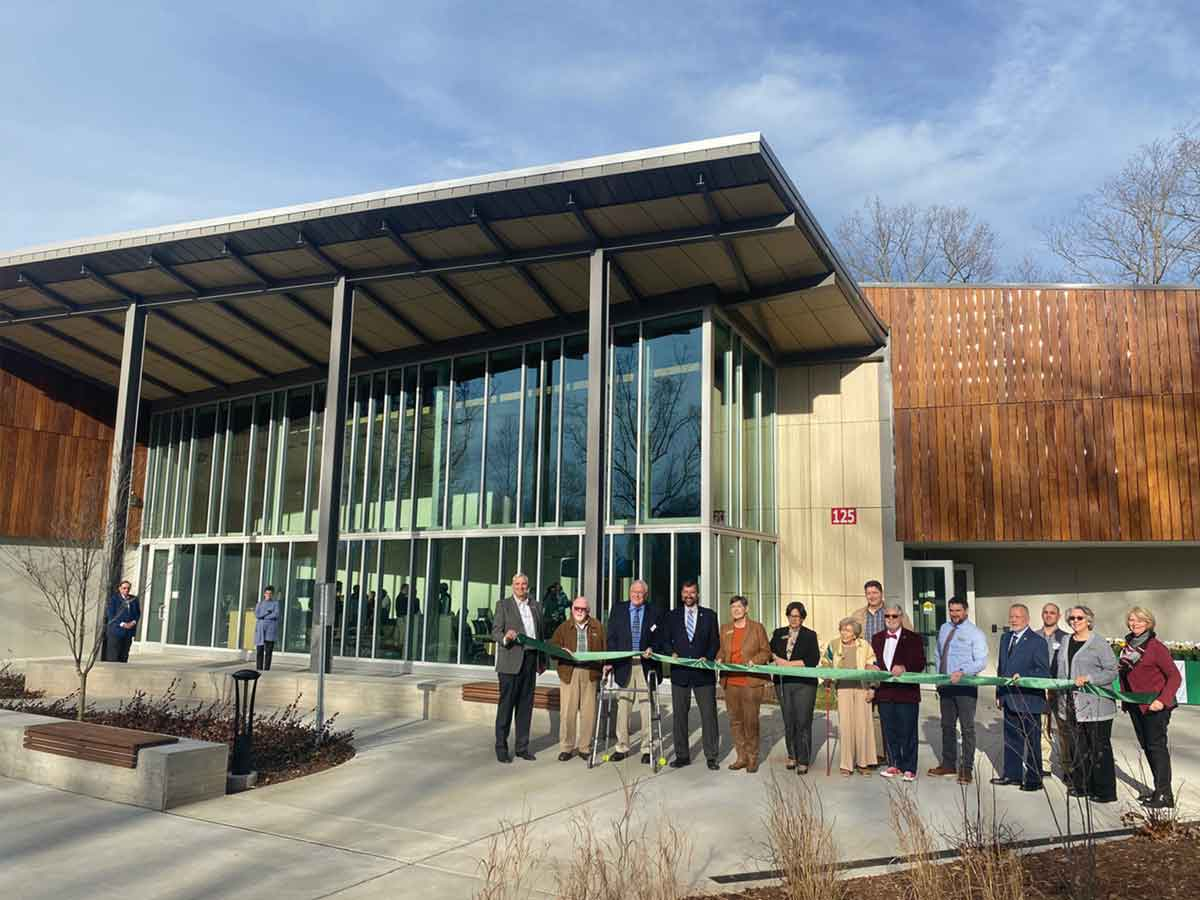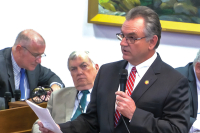HCC opens new health sciences building amid statewide nursing shortage
 Haywood Community College’s new Health Sciences Building is impressive to look at, but it’s what’s inside that really counts as it will expand, enhance and modernize the nursing student experience.
Haywood Community College’s new Health Sciences Building is impressive to look at, but it’s what’s inside that really counts as it will expand, enhance and modernize the nursing student experience.
At a time when North Carolina faces a serious nursing shortage, Haywood Community College has invested in its nursing program with a new Health Sciences Building. Full of the latest educational technology, it will expand, enhance and modernize the nursing student experience, preparing the next generation for a career in healthcare.
“This is an exciting day, a very proud day for Haywood County,” said Haywood County Commissioner Kevin Ensley. “I want to thank [Haywood Community College President] Dr. [Shelley] White for her leadership.”
On Tuesday, Nov. 29, Haywood Community College held a ribbon-cutting ceremony for its new Health Sciences Education Building. Community pride was palpable with almost 200 college faculty, supporters, students and elected officials filling the sunlit lobby for the occasion.
Nursing was one of the first programs available at Haywood Community College. For many years it was an LPN program in Canton, available through AB Tech. In 1981 that became an associate degree option at the college which made students eligible to sit for the RN licensure. Now, the nursing program at HCC is the only consortium left in the state and includes Tri-County Community College in Cherokee County.
Students at the Tri-County Community College take their second year of courses at HCC and so will also benefit from the new building and new equipment.
“It really reaches even beyond Haywood Community College for how many students it will reach and how many people in the region,” said Dr. Lorene Putnam, nursing consortium program director.
Related Items
The new building doubles existing space for health sciences at the college. It is set up to mimic a real hospital unit with eight simulated hospital suites and as many spaces for skill development, as well as a practice lab.
An 85-seat, graduated lecture hall will host seminars, while the hands-on learning will take place partially in the 40-seat biology lab. In addition to nursing classes, routine biology classes will also be able to use the lab in the new building. This lab is home to an Anatomage table, essentially a human-sized tablet with multiple bodies scanned into it allowing students to dissect and examine human bodies virtually.
“There’s several people scanned in that and they can be dissected electronically,” said Putnam. “It’s a very cool product. The students can learn so much from this machine.”
Two other 60-seat classrooms in the building are set up for collaborative work between teachers and students.
“We intentionally did not put all of the focus at the front where you know the ‘sage on the stage’ is talking, it’s a collaborative room,” said Putnam. “It can be a lecture room, but if you notice the monitors are on each corner of the room, so students can work as groups and solve problems.”
The skills lab is perhaps most exciting for teaching staff in the nursing program. Where the school used to have a three-bed skills lab, the new building hosts a spacious eight-bed skills lab replete with several types of mannequins that can simulate real-life nursing situations.
A bariatric manikin provides practice in the lab with morbidly obese individuals who may present challenges in movement, bathing and procedures. A birthing mannequin can simulate a true childbirth experience. Anyone who has never been inside a nursing skills lab before may be surprised to find a room full of mannequins in hospital beds, eyes blinking, chests breathing, and monitors actively informing students of vital signs. These mannequins can simulate a wide range of medical emergencies.
“We have a child [mannequin] that’s like a four or five year old,” said Putnam. “We have various skin tones which is very important. We need more diversity in nursing, and we need more experience for people in that space.”
Realistic medication storage and dispensing equipment provide hands-on learning of the important skill of medication administration. During these realistic scenarios, many other activities and patient condition changes are happening while students may be required to safely retrieve multiple medications for multiple patients over the course of simulation.
This vast array of augmented reality equipment exposes students to various medical-surgical and obstetric pre-programmed experiences with the guidance of a faculty that allows for prioritizing decision-making and application, followed by discussion.
“In a rural area, we sometimes don’t have the volume of critical things going on where students can witness different things happening. We can make any of those happen with these mannequins,” said Putnam. “If that happens in the hospital, even when it does happen when we’re there, a student will get whisked away into a corner to watch because the quick thinking of someone who has been through all of the training is going to be the difference in life and death.”
On the contrary, in a simulated lab, Putnam said, students can practice different scenarios multiple times, with teachers watching, and debrief after each session to discuss what went well and what went wrong.
“It is a marvelous way to teach, and don’t you want the nurse that for the first time has to make that decision for your loved one to have practiced that and been able to think through that?” asked Putnam.
The new building was made possible by a $5 million grant from the Haywood Healthcare Foundation. In 2019, then HCC president Dr. Barbara Parker went to the Haywood County Commission with a big request. The college wanted to construct a $7.2 million Health Sciences Education Facility.
Parker already had $2.8 million to go toward the project from funds allocated through the Connect NC Bond. North Carolina approved the bond, allowing the state to borrow $2 billion for campus construction and infrastructure, in 2016. But the college would still need about $5 million to get the project done. When Parker went before the Haywood County Commission in 2019, those Connect NC Bond dollars needed to be allocated soon — the money would have been forfeited if not used before 2021.
The $5 million was a big ask from the county government, but Haywood County Health Foundation stepped in to provide the needed funding.
Initially created in 1978 as a fundraising group for the Haywood Regional Medical Center, HHF could no longer do so after Duke bought the hospital in 2017 and it became a for-profit entity. Instead, the county commission voted to allow HHF to administer $20 million in profits from the sale of the hospital.
“The Haywood Healthcare Foundation Board is proud to have partnered with Haywood Community College to fund a significant amount of money. And look what we have here today,” said Neil Budde, vice chair of the HHF board, motioning around the building’s lobby. “It’s going to help address the shortage of healthcare workers throughout not only Haywood County but elsewhere as well.”
The college received over $700,000 in grants for the new, high-tech equipment in the building. The Cannon Foundation donated $150,000 to go towards simulation mannequins, Golden Leaf Foundation granted $300,000 for equipment, and the estate of Camilla McConnell donated $100,000 for the Anatomage table in the biology lab.
Dogwood Health Trust recently awarded Haywood Community College a grant for $226,735, also for equipment. This money funded the purchase of a bariatric manikin, medication storage/ dispensing units, skills training materials and augmented reality training equipment.
Several of the elected officials who attended the ribbon-cutting ceremony touted the importance of community colleges for families in the area and the economy at large. Commissioner Kevin Ensley, as well as Reps. Mark Pless and Mike Clampitt, who spoke at the event, have all graduated from community college programs.

- Here’s a look at one of the rooms where future nurses will learn how to deal with any number of patient issues that may arise.
“I became friends with a lot of folks that work at Hayward Regional Medical Center, who were trained at Haywood Community College. They had the heart, they had everything they needed to help people and take care of people, and they were able to reach those goals through the [college],” said Pless. “We already have the people in Haywood County with the heart, now we’re providing them with the tools.”
Nurses are the single largest sector of the United States healthcare system with over 3 million individuals employed. They are also the people who spend the most time with patients, by a significant margin, and therefore play a central part in increasing the value of healthcare by improving outcomes. However, this also means that a shortage of nursing staff can have a devastating effect on the healthcare system.
In North Carolina today there are over 120,000 nurses at an average age of about 53.
Evidence suggests that since 2020 the number of nurses renewing their licenses in North Carolina has risen by a small percentage. Additionally, the number of students completing the licensure exam has risen by a small margin and the number of nurses moving into the state from elsewhere to work here has also gone up. However, this is doing almost nothing to compete with the number of nurses leaving the field.
According to research from a 2021 mercer study, North Carolina faces a large gap between the number of registered nurses needed in the state, and the number employed in the healthcare industry. In 2022 the gap was estimated at a shortage of over 4,000 RNs. As soon as 2026, the gap is estimated at over 13,000. In these shortage projections North Carolina is second only in the nation to Pennsylvania.
This is a result of many factors, including the relatively high average age of nurses employed in North Carolina, combined with those leaving the profession due to burnout that is perpetuated by understaffing.
In Haywood County alone, Haywood Regional Medical Center is currently listing about 100 open positions for registered nurses, certified nursing assistants, nurse practitioners and licensed practical nurses.
“I can speak for the entire board when I say Congratulations to Dr. Shelley White, and the whole Haywood Community College team,” said Budde. “This is a wonderful addition for not only Haywood Community College, but for Haywood County, and Western North Carolina.”
“We are so grateful for all of these opportunities,” said Putnam. “Thank you so much for supporting us at Haywood Community College.”









